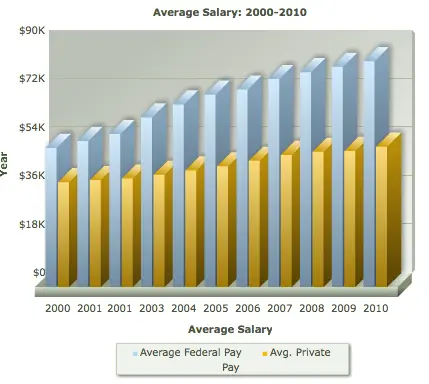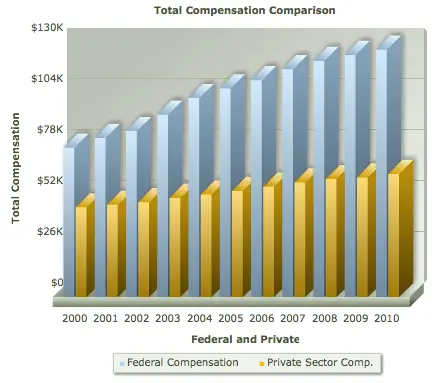Federal employee pay is always a source of interest…and controversy.
A case in point: We recently ran an article with a chart showing federal vs. private sector pay. Numerous readers submitted comments. Among the comments were those that read something like this: “Why didn’t you include any data past 2008?” And, occasionally, someone would infer we were trying to hide data favorable to federal workers by not including data for the last two years.
So, for those who were asking these and similar questions, we have done the additional research to provide additional data. We will leave it to each reader to determine whether the federal salary levels are too high, too low or just about right after reviewing the available information.
Salary Data from U.S. Bureau of Economic Analysis
The underlying data is compiled by the U.S. Bureau of Economic Analysis (BEA), part of the Department of Commerce. When looking at federal pay, you will find that OPM compiles one set of statistics, BEA has another and the Federal Salary Council apparently uses different data or at least uses some of the data to reach its own conclusions.
As one reader observed in our recent article, people often interpret data based on what is in their own economic interest. In general, those that disagree with the data presented will often attack the credibility of the messenger or the organization reporting the information, often while not presenting any other arguments. With that in mind, here are the data showing private sector vs. federal pay based on data from the BEA and as brought to light by Chris Edwards of the Cato Institute. Mr. Edwards has been compiling and analyzing pay data from the BEA for a number of years and occasionally reports the BEA results in a separate report and analysis such as this report on federal pay issued in February 2012. For those who may want more information or want to look at the raw government data, check out Tables 6.2D, 6.3D, and 6.5D on the BEA website which is the data used by Mr. Edwards for his analysis.
Lowest Federal Pay Increase in 10 Years
For those who may be wondering why we did not include data from 2011, it is not yet available. However, according to an analysis by USA Today, despite the federal employee pay freeze, federal salaries still went up faster than salaries in the private sector although the increase in federal pay was the lowest it has been in 10 years. “Federal pay rose an average of 1.3% for the budget year that ended Sept. 30, according to newly released federal data. By comparison, the wages of private workers rose 1.2% during the period, the same rate as state and local government pay growth….”
How did federal pay go up despite a pay freeze? Salaries did go up for some federal employees as within-grade increases and promotions were not frozen. Some readers have also reported that in their agencies some jobs have been reclassified with the result that people receive higher pay as a result of the reclassification.
Average Federal Salary and Average Compensation Including Benefits
According to BEA data, the average federal employee salary in 2010 was $83,679 and $51,986 for the average private sector salary.
When benefits are added in, the average compensation for each federal employee comes to $126,141. For private sector workers, the average compensation package, including benefits, was $62,757 for the same year.
A number of frequent observations are submitted by readers on articles regarding federal pay. One of the most common is that the federal government employs people with different skill sets so comparing average pay with the private sector is not meaningful.
Cato analyst Chris Edwards addressed that issue in his report.
“…[T]he federal workforce has always had a heavy contingent of skilled professionals such as lawyers. So that is not new, and thus it cannot explain the dramatically faster growth in federal compensation compared to private compensation….In 2000, the average federal worker earned 66 percent more in total compensation than the average private-sector worker. By 2009, that ratio had risen to 102 percent.
There are several apparent reasons for the rapid rise in federal employee salaries. As we have pointed out in earlier articles (See Highly Paid Federal Administrative Positions: Where Are They and How Much Do They Make?) many federal employees are now outside of the general schedule pay system and their agency budgets are often derived from fees they collect from regulated industries. Employees in these agencies often have higher salaries than employees in the same job classification for other agencies. That contributes to a higher overall salary level.
Also, the Veterans Administration (VA) is now paying higher salaries to the doctors that it hires to work for the agency. It is not a coincidence that, when reviewing individual salary levels for federal employees, and sorting the data from the highest salary to the lowest, most of the highest pay rates are going to doctors working for the VA. USA Today reports that pay for doctors in this agency has now doubled to an average $200,604 in 2011.
Politics also plays a role. Federal employee salaries have climbed faster than inflation so far in the 21st century. One reason is that the administration of President Bush supported large pay increases for military personnel to improve recruiting and retention in the military. Lobbying for “pay parity” emanated from federal employee unions and Congressional representatives with large numbers of federal employees was successful. In effect, federal civilian employees also gained hefty salary increases as an indirect result of America’s combat operations in Afghanistan and Iraq. (See Patriotism, Pay, and Parity) In effect, some of the largest pay increases for federal employees occurred under the Bush administration from 2000 – 2008.
And, as most readers know, the Federal Salary Council has also pushed large salary increases for federal employees each year; that is, they have pushed for much larger salary increases than employees have received. The Salary Council has a very large union component and agencies that often are philosophically aligned with union goals and objectives so there is skepticism outside of the federal community regarding the accuracy of these figures. As noted by Edwards’ analysis:
“The government’s Federal Salary Council releases an annual memo reporting on the size of the supposed pay gap, which in 2009 was 26 percent. The gap is supposed to be determined based on job-to-job comparisons, but the results rest of calculations that are non-transparent and subject to a large amount of statistical modeling….The official pay gap was 22 percent in 2001 and 26 percent in 2009….Yet the BEA data show that average federal salaries rose 58 percent between 2000 and 2009, which was much faster than the 30 percent increase in the private sector. Since the BEA data are authoritative, there must be something wrong with the official pay gap methodology.”
Congressional representatives in areas surrounding Washington, DC and other large concentrations of federal employees want to provide higher benefits for their constituents and federal employees are a powerful interest group and effective lobbyists. Whether justified or not, the Federal Salary Council data has undoubtedly influenced some Congressional deliberations to the benefit of the federal workforce.
Job-to-Job Comparison
Many readers often comment that if the same or similar jobs are compared, federal workers make less than their private sector counterparts. No doubt, that is true in some cases. However, an analysis by USA Today found:
“Federal employees earn higher average salaries than private-sector workers in more than eight out of 10 occupations….Accountants, nurses, chemists, surveyors, cooks, clerks and janitors are among the wide range of jobs that get paid more on average in the federal government than in the private sector.”
The discrepancy gets wider when benefits are included. In 2010, the average federal employee benefit package was worth $42,462. For private sector workers, the average benefits package was worth $10,771 according to BEA data.
The Bureau of Labor Statistics reports that 216 occupations covering 1.1 million federal workers exist in both the federal government and the private sector. An additional 124 federal occupations covering 750,000 employees such as air-traffic controllers and tax collectors, do not have equivalent jobs in the private sector.
Additional information on federal salaries versus the private sector was provided by the Congressional Budget Office (CBO) in a recent report. This CBO study concluded:
- Federal civilian workers with no more than a high school education earned about 21 percent more, on average, than similar workers in the private sector.
- Workers whose highest level of education was a bachelor’s degree earned roughly the same hourly wages, on average, in both the federal government and the private sector.
- Federal workers with a professional degree or doctorate earned about 23 percent less, on average, than their private-sector counterparts.
In other words, the federal government often pays salaries that are higher than the private sector at the lower end of the skill levels required and often pays lower salaries than the private sector when more complex skills are required.
Summary
Without a doubt, the controversy regarding federal pay levels will go on. Many in Congress will use the data to justify cutting federal pay and benefits. The Federal Salary Council will probably continue to assert federal employees are underpaid. There is no evidence that the Office of Personnel Management will make an effort to resolve the continuing controversy anytime in the immediate future.
The data do show that many in the federal government make a decent salary and have better benefits than many workers have in the private sector. And, no doubt, many federal employees, particularly at the higher skills levels, would make a higher salary in the private sector.
We have provided the data and some of the reasons for the controversy. Feel free to reach your own conclusions and comment as you see fit.




